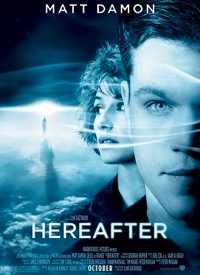
Hereafter effectively brings spirituality to real-life events, ranging from the now-historic 2004 Indonesian tsunami to the terrorist attacks of a London train station. It highlights the very question nearly every person asks, particularly during the most trying times: What happens after death? Hereafter ventures a guess that will help audiences remember their faith.
Directed by Clint Eastwood, Hereafter simultaneously tells the story of three people, each heart-wrenching, though in dramatically different ways.
George Lonegan (Matt Damon) was blessed with psychic abilities after he suffered from a menacing condition as a child, though “blessed” would not be the term George chooses. By the mere touch of the hand, George is able to see another’s pain, and help them to communicate with a lost loved one. After making a career of his talents, he quickly learned that to encounter another’s pain on a regular basis is debilitating to his very existence. He decides to resign his position as a well-renowned psychic and takes a job in a factory, hoping to run away from the “gift” that he calls a “curse.”
Marie Lelay (Cecile De France) was one of the lucky few survivors of the tsunami, though her rescue was a close-call. Having nearly drowned, Marie teetered on the line between life and death, and in doing so, was given a brief glimpse of the afterlife. Days and months after the close encounter with death, Marie cannot help but wonder whether her vision was in fact real, or a mere hallucination brought about by her unconsciousness. Her intense confusion gives way to an all-out investigation.
Marcus (Frankie/George McLaren) is the younger of twins, by a mere 12 minutes. His brother, Jason, is tragically taken when he is hit by a speeding vehicle, leaving Marcus alone to deal with his mother, who is addicted to drugs and alcohol. Shortly after Jason’s death, Marcus’ mom decides to relinquish care of her son to children’s protective services so that she may seek proper care for her addictions, but Marcus cannot help feeling abandoned by his mother and brother. Desperate to speak to his brother yet again, he attempts to enlist the help of George Lonegan, a man who wishes to forget that he has the ability to communicate to the dead.
One character trait shared among all three characters is the absence of faith and religion. George, Marie, and Marcus find themselves searching for answers as they are confronted by elements in their lives larger than themselves.
People of faith are fortunate to take refuge in the knowledge that we are small components of a larger plan — that life for a good person can culminate in a serene, pure afterlife. Without belief in such a comforting notion, George, Marie, and Marcus search for answers, eventually finding consolation in each other.
What’s most notable, however, is that the answer they discover is God, though they may not quite know it. Yet people of faith will watch and know that the serendipitous meetings of these individuals could only have been guided by the hand of God.
Likewise, the film seems to attempt to confirm the existence of God through rational research. Suddenly questioning her secular world view, Marie visits a doctor whose experiences in a hospice facility forced her to confront her own atheism. The doctor explained to Marie, “As a scientist and an atheist, my mind was closed to such things.” However, the doctor reveals that patients claiming to have had near-death experiences tend to describe similar experience, whether they were raised to believe in a higher power or not. The doctor explains that once she opened her mind, the answer to life’s toughest questions was so simple: There is a God.
Because the film addresses such spiritual questions, it is a peculiar decision on the part of the film’s writers to give a quasi-natural explanation to a supernatural endowment by attributing George’s psychic abilities to his childhood disease.
Despite the film’s title, it is important to note that Hereafter is less about the afterlife and more about grief and the search for answers. However, when it is depicted and described on film, the afterlife appears similar to Heaven, a place of light. During one of George’s rare psychic encounters, he’s told that the afterlife is a place where “You can be all things at once.”
The film also criticizes the illegitimate “psychics” who, with no real psychic abilities, attempt to profit off others’ grief. This is particularly evident when Marcus is portrayed in a montage of psychic visits, each proving to be more bogus than the last.
Hereafter opens with a spectacular recreation of the 2004 Indonesian tsunami. In fact, theatricality is a high point for Hereafter, as many of the quickest scenes pack the biggest punch.
Where the movie suffers is in the clumsy and sloppy conclusion. The plot’s ending seems to close conflicts that were not apparent from the beginning, and wraps an all-too perfect bow around the story.
Damon continues to astound audiences with his incredible talent, evident in Hereafter. His performance is convincing, as he aptly depicts a man torn by self-doubt and a desire to assist others alongside the natural human instinct of self-preservation. His character’s love of Charles Dickens is artfully portrayed when he both listens to Dickens’ book readings and as he participates in a tour of Dickens’ home in England.
The other actors, however, appeared devoid of real emotion. In the case of Cecile De France, her storyline is not as emotional as it is intellectual, providing her emotional leeway in her performance. George and Frankie McLaren, however, are seemingly ill-equipped to perform in such dramatically intense roles, perhaps coasting on their precious and generally melancholic looks.
Overall, despite the few low points, Hereafter is a great movie. Each narrative is simplistic, yet full of profoundly real conflict, to which any moviegoer can relate, specifically the fear of death and the unknown. Hereafter does not include much action, instead focusing on internal conflicts and emotional struggles. Much of the film is overwhelmingly sad, but so true to life.




